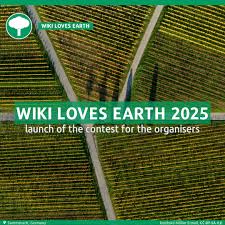India, with its incredible biodiversity — from the snow-capped Himalayas to the lush Western Ghats and vibrant coral reefs — is a treasure trove of natural wonders.
To document and showcase this rich natural heritage, Wiki Loves Earth (WLE) — a global photography competition organized by Wikimedia — invites photographers and nature enthusiasts to capture protected areas and upload them to Wikimedia Commons under a free license.
In 2025, the competition returns to India, offering a unique opportunity for photographers to contribute to open knowledge while highlighting the beauty of India’s ecosystems.
This article will guide you through everything you need to know about Wiki Loves Earth 2025 in India, including how to participate, rules, tips, prizes, and FAQs.
Table of Contents
What is Wiki Loves Earth?
Wiki Loves Earth (WLE) is an annual international photographic competition, launched in 2013 by Wikimedia Ukraine.
Its goal is to:
Document protected natural areas around the world.
Raise awareness about conservation.
Expand the repository of free, high-quality nature photographs on Wikimedia Commons — which are used on Wikipedia and beyond.
Participants take photos of national parks, wildlife sanctuaries, biosphere reserves, natural monuments, and upload them under a Creative Commons license.
India has been participating in WLE since 2014 and has contributed thousands of stunning images of its biodiversity.
Why is Wiki Loves Earth Important in India?
India is one of the 17 megadiverse countries, with:
Over 100 national parks
More than 550 wildlife sanctuaries
Numerous wetlands, rivers, mountains, forests, and marine ecosystems.
Documenting these areas:
1. Promotes awareness of conservation.
2. Supports free knowledge and open data.
3. Inspires future generations to protect biodiversity.
When is Wiki Loves Earth 2025 in India?
Start date: june 1, 2025
End date: july 31, 2025
This one-month window aligns with the international WLE calendar. Submissions are accepted only during this period.
Who Can Participate?
Anyone — from amateur photographers to professionals — can participate.
There are no age restrictions or entry fees.
Even if you are not a professional photographer, your contribution to documenting India’s biodiversity is invaluable.
How to Participate in Wiki Loves Earth 2025 in India?
Here’s a step-by-step guide:
1. Choose Protected Areas
Photograph protected areas in India, such as:
National Parks: e.g., Jim Corbett, Kaziranga, Gir Forest.
Wildlife Sanctuaries: e.g., Bharatpur Bird Sanctuary, Bhadra.
Biosphere Reserves & Ramsar Wetlands.
Any area officially listed as protected.
You can find lists of protected areas on WLE India pages and the Ministry of Environment & Forests site.
2. Take Photos
Capture high-quality, original photographs that showcase:
Landscapes, ecosystems, and habitats.
Flora & fauna in their natural setting (animals in captivity generally do not count).
Unique geological formations, rivers, lakes, etc.
3. Create a Wikimedia Commons Account
If you don’t already have an account, create one at Wikimedia Commons.
4. Upload Your Photos
During the contest period, go to the WLE India upload page.
Select the appropriate protected area from the list.
Provide descriptions, location details, and the date taken.
Agree to release your photo under a free license (Creative Commons BY-SA).
5. Wait for Judging
After the contest ends, your photos will be reviewed by a panel of judges. Winning photos are announced within a few months.
What are the Rules?
1. Photos must be taken by you.
2. Photos must be uploaded to Wikimedia Commons during the contest period.
3. Photos must depict protected areas or species within protected areas.
4. You can upload as many photos as you want.
5. Photos must meet Wikimedia Commons’ technical and licensing requirements.
- No copyrighted or watermarked photos.
- No manipulated or misleading images.
Prizes & Recognition
Wiki Loves Earth is both a national and international contest.
National prizes: Top entries from India win prizes (cash, gadgets, certificates).
International prizes: The top 15 photos globally are selected for international awards.
Winning photos are featured on Wikipedia, Wikimedia Commons, and other platforms, reaching millions of viewers worldwide.
Tips for Taking Winning Photos
1. Shoot during early morning or late afternoon for best light.
2. Focus on unique angles and perspectives.
3. Show context: a tiger in its lush jungle habitat is more powerful than a close-up alone.
4. Pay attention to sharpness and composition.
5. Include captions and descriptions that clearly identify the location and subject.
Notable Entries from Past Years
India has contributed many award-winning photographs to WLE:
A snow leopard from Hemis National Park.
The colorful wetlands of Keoladeo National Park.
A spectacular sunset in the Western Ghats.
These images not only won prizes but also raised global awareness of India’s natural treasures.
Benefits of Participating
1. Promote India’s natural heritage.
2. Contribute to free knowledge & education.
3. Gain recognition in an international photography community.
4. Improve your photography skills.
5. Potentially win exciting prizes!
Challenges to Watch Out For
1. Accessibility: Some protected areas have restrictions or require permits.
2. Weather conditions: Plan for seasonal monsoons or heat.
3. Wildlife safety: Maintain a safe distance and respect animal habitats.
4. Legal compliance: Do not enter restricted zones or violate rules.
Impact of Wiki Loves Earth
Since its inception, WLE has:
Added over 1 million images to Wikimedia Commons.
Documented protected areas in more than 100 countries.
Raised global awareness about conservation and open knowledge.
In India, it has highlighted lesser-known sanctuaries and ecosystems, encouraging eco-tourism and conservation efforts.
FAQs about Wiki Loves Earth 2025 in India
Q1: Do I need to pay to participate?
A: No. Participation is free and open to everyone.
Q2: Can I upload photos taken in the past?
A: Yes, as long as they were taken by you and depict protected areas still in existence.
Q3: Can I submit photos of animals or plants?
A: Yes, but they should be within a protected area.
Q4: How many photos can I upload?
A: There is no limit. You can upload as many relevant photos as you want.
Q5: Do I keep the rights to my photos?
A: Yes, but you agree to release them under a Creative Commons BY-SA license, allowing anyone to use them freely with attribution.
Q6: Can I participate if I’m not a professional photographer?
A: Absolutely! Anyone with a camera or smartphone can contribute.
Q7: Where can I find a list of eligible protected areas?
A: On the WLE India page or government websites listing India’s protected areas.
Conclusion
Wiki Loves Earth 2025 in India is more than just a photography contest — it’s a celebration of India’s breathtaking biodiversity and a powerful way to contribute to conservation and education.
By participating, you not only showcase India’s natural wonders to the world but also join a global movement dedicated to preserving our planet’s treasures for future generations.
So grab your camera, explore India’s protected areas, and share your vision with the world through Wiki Loves Earth 2025!











